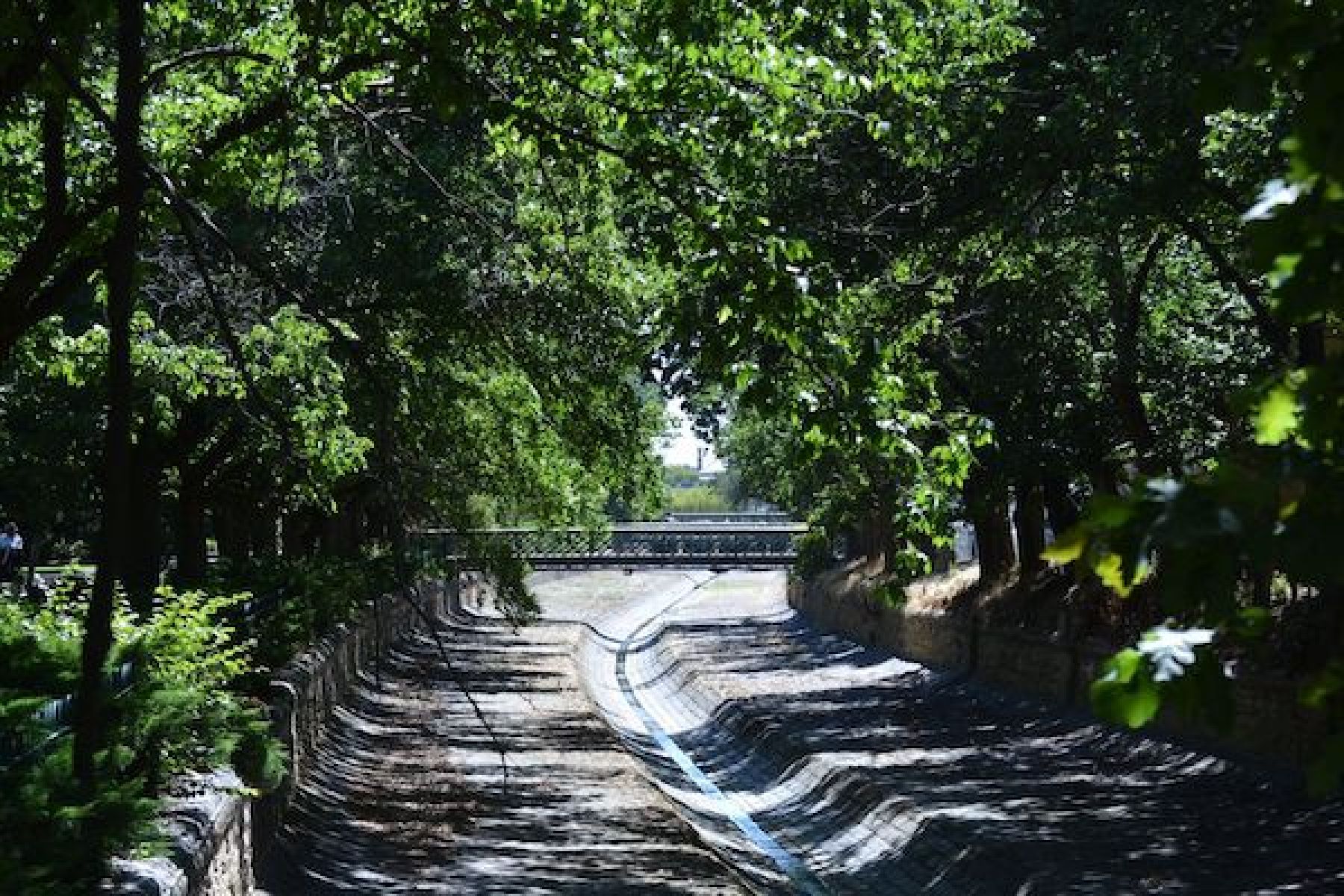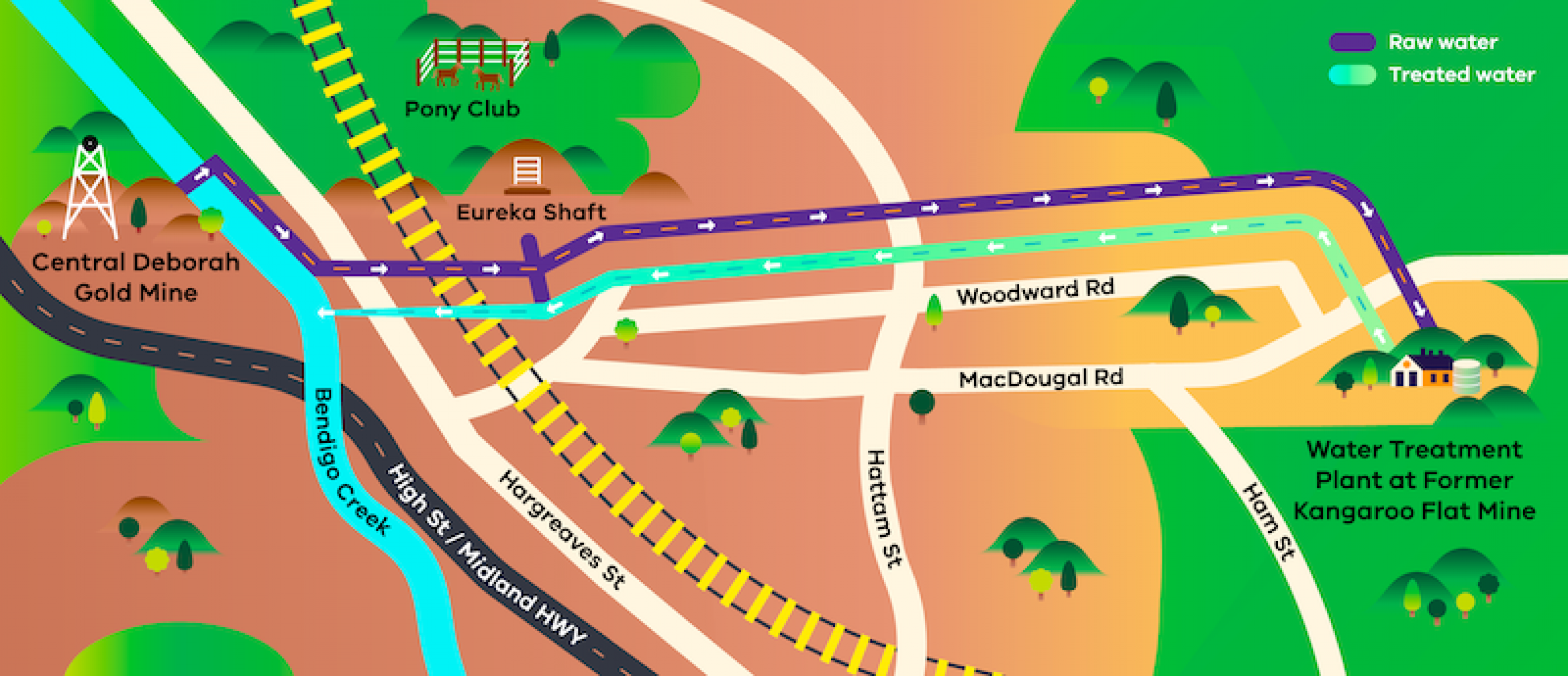On this page:
Register for updates
The Central Bendigo Mine Rehabilitation Project
Gold mining has been good for Bendigo, but not without consequences. As mining operations have wound down, groundwater has continued to rise back to natural levels and begun to affect the liveability of the city.
Mine-impacted groundwater contains naturally occurring arsenic and other elements, including smelly sulphides.
For the past decade, the Victorian Government has taken direct action to stop increased flows of this water in the city. However, that action was only designed to provide a short-term fix while a long-term solution was devised.
The Central Bendigo Mine Rehabilitation Project — Groundwater is the long-term solution for:
- dealing with rising mine-impacted water volumes
- managing odours from sulphides
- protecting the amenity of Bendigo Creek.
The project will see groundwater pumped from the Central Deborah Gold Mine, treated at a purpose-built treatment plant and returned to Bendigo Creek. This will address the impacts on Bendigo City and allow Central Deborah to continue to function as one of Bendigo’s star tourist attractions.
The project team is currently working on design, tendering and approvals. Pending approvals processes, works are expected to commence in 2025. It is anticipated that construction will take about 2 years to complete.

Scope of the project
In its 2022-23 budget, the Victorian Government funded $51.83 million to deliver an integrated management solution.
This solution was developed in consultation with several agencies and the Dja Dja Wurrung Clans Aboriginal Corporation (DJAARA) and includes:
- design and construction of a new purpose-built water treatment plant and associated pumping station and pipelines
- decommissioning the existing interim infrastructure
- infrastructure improvements at Central Deborah Gold Mine which is a heritage tourist attraction.
The community will get a long-term sustainable solution and there are benefits from the improved amenity of Bendigo Creek.
Project location

View a larger version of this map.
The Victorian Government will continue to pump and treat mine-impacted groundwater around the Central Deborah Gold Mine site and near the CBD.
DEECA and project stakeholders identified the former Kangaroo Flat Mine site as the preferred site for the water treatment plant.
The treatment plant will have a small site footprint (0.5 ha) and be quiet and discrete. The plant will be located near the existing site entrance to align with rehabilitation plans.
It will consider site access, utilities and suitable buffer distances from residents. Site rehabilitation plans are also being considered.
Central Deborah Gold Mine will continue to be the primary pumping site.
The mine has underground connections to both historic and modern mine workings. Pumping from them ensures that the mine-impacted groundwater beneath central Bendigo continues to be managed. The treated water will be returned to Bendigo Creek providing additional flows for the environment.
Reason for the project
Large volumes of mine-impacted groundwater exist in historical mine workings beneath the city of Bendigo. The water contains some metals including arsenic and sulphides, which can produce odours.
Prior to mining recommencing in the 1980s, unmanaged discharges of mine-impacted water occurred in Bendigo's CBD. This resulted in odours throughout the city. Up until 2011, these discharges to the creek were prevented by modern mining operations.
When mining ceased, water levels started to rise. This posed a risk of large unmanaged discharges reoccurring. In 2015, the Victorian Government continued management of the water through a temporary management program. It used refurbished mining equipment and facilities.
Much of this infrastructure is operating beyond its design life. The solution is costly to run and has faced various operational issues over the past few years.
The solution also required the construction of a brine waste lagoon, and this lagoon has limited capacity. The waste in the lagoon will require disposal at a licenced landfill at a high cost. The temporary management program has reached the end of its life.
Now it requires replacement to avoid increased discharges in the CBD, to maintain the historic workings at Central Deborah Goldmine and to protect and enhance Bendigo Creek.
Groundwater under Bendigo's CBD
Large volumes of mine-impacted groundwater exist in historical mine workings beneath the city of Bendigo. These elements occur naturally within the bedrock beneath Bendigo. They can however be released into the groundwater when unearthed by mining activities and left to interact with water and air.
Without management, this water would seep into Bendigo Creek, releasing odour and metals in the centre of Bendigo. This would affect the creek's water quality and biodiversity and flood the Central Deborah Gold Mine tourist attraction.
The groundwater system in Bendigo is shaped by the underlying geology, a naturally high saline water table and a mining history spanning more than 150 years.
Areas of seepage of mine-impacted water to the Bendigo Creek historically occurred when groundwater returned to pre-mining levels. This was after the closure of the last underground mine in 1954 until the 1980s.
However, when modern mining started, these seepages were reduced as water was pumped from underground to create dry conditions for mining operations.
Research and development
Over the past 5 years, DEECA has undertaken many studies into the groundwater issue, consulted with various experts and regulators, and engaged with the local community and stakeholders.
During the scoping stage, a range of management options were identified. The solution was selected following a technical and consultative process.
A State and Local Government advisory group, with an independent chair, was appointed to oversee the process.
Based on current information, which will be updated as the project goes through the design and approval stages, the solution proposes:
- removing mining related contaminants and
- releasing water treated to an EPA licenced standard, into Bendigo Creek, providing environmental flows.
DEECA is working across government to ensure mining remediation and rehabilitation projects in Bendigo are addressed in a coordinated and collaborative way. The aim is to achieve the best and safest long term environmental and community outcomes
Improved environmental understanding
Since the temporary management program was first implemented, we have improved our understanding of Bendigo's groundwater systems and how they are affected by mining.
Best practice management for mine closure is generally to flood the historical mine workings to the highest levels practicable.
As part of the new solution, we have already altered our pumping approach, allowing water levels to increase and flooding exposed workings. Flooding workings slows further generation of metals and sulphides which result from exposure to air and cycles of wetting and drying.
Consultation
DEECA has worked closely with the independently chaired State and Local Government Advisory Group. Its members are:
- Dja Dja Wurrung Clans Aboriginal Corporation (DJAARA)
- Bendigo Heritage Attractions
- City of Greater Bendigo
- Coliban Water
- North Central Catchment Management Authority
- Earth Resources Regulation
- Regional Development Victoria
- Goulburn Murray Water and
- EPA (as an observer).
DEECA has also widely engaged with industry and technical experts in developing its approach.
Since August 2017 the Victorian Government has been partnering with Coliban Water to manage the groundwater from central Bendigo's underground mining voids.
The management aims to prevent any new discharges of mine-impacted groundwater into Bendigo Creek. This will also allow for the continued operation of the Central Deborah Gold Mine tourist attraction.
The infrastructure set up for this was only designed as a temporary solution and is reaching the end of its usable life.
Both the Victorian Government and Coliban Water are committed to ensuring the groundwater continues to be managed. They will continue working together until the long-term management system is in place.
The project team is happy to meet with community members or groups to discuss the project and can be reached via email.
Page last updated: 01/09/25
